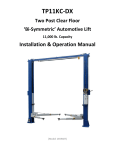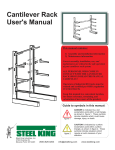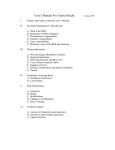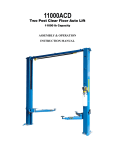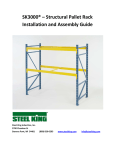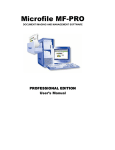Download User Manual for Interlake`s Storage Rack Products
Transcript
Stay on walkways. Do not walk in any areas that are not designated walkways. This is particularly true in pick modules. Pick modules are racks designed with a multi-level walking aisle between racks to allow workers to pick or select materials from the racks. Prevent falling merchandise. The loads you place should be in good condition and shrink wrapped, banded, or otherwise confined to prevent falling material. Crossbars may be used to help keep undersized or misplaced loads from falling. If unstable loads are stored, items may fall, and the spillage of this material may cause property damage and serious or User Manual for Interlake’s Storage Rack Products Interlake recommends that you train and instruct your workers: fatal injury. • Never step on the pallet storage area above ground level. Check for corrosion to any components, including beams and columns. When rust appears, the racks should be wire-brushed and coated with a corrosion resistant coating. Significantly corroded items (marked by delamination, repeated flaking of metal, holes, or other evidence of corrosion) should be replaced. • If pallets or other items must be pulled to the picking aisle or walkway, this should be done without stepping on the pallet storage area. If you do not follow this simple rule, you must follow the minimum requirements stated in Interlake’s Safety Notice Regarding Pick Modules at www.interlake.com. Identify and address any column damage. Column damage can reduce the capacity of the rack and should be addressed immediately. Severe column damage can cause one or more bays of racks to collapse. It is possible for damage to be repaired, but repairs must be performed by a well-trained team. Contact the Interlake Safety Solutions and Services Department or your Interlake distributor for more information. Never climb on racks, or step on racks, before, during, or after assembly. Racks are not designed or intended to be used as a climbing, walking, or working surface. Wire mesh decking is not a safe walking surface. Do not allow operators to step on wire mesh decking. Serious injury may occur as a result of misuse of the storage racks. Make certain that your fork truck equipment has state of the art safety devices. These may include, but are not limited to, devices that provide protection from falling objects, protection against accidental operator injury due to backing up into an object, and protection against accidental falls. Check with your fork truck supplier for more complete information. Never use intoxicating substances while working with and around Interlake rack systems. Alcoholic beverages and other intoxicating substances may impair a person’s perception and motor function. A resulting slip or fall may cause serious injury. Impaired fork truck operators can seriously damage racks, which can lead to serious or fatal injury. Establish a fork truck operator training program. This should include not only the OSHA required training, but also ongoing training. An emphasis should be placed on safety. Damage to the rack is a safety hazard for the operator as well as for other people who may be in the area. Review your operations for other potential hazards and adopt appropriate safety procedures. This Manual is not intended to and is not able to address all possible safety considerations that may arise in your operation or in your use of storage rack. • Instruct your operators to report any damage to rack or locking devices that may impair the safety of your system. To: Owners and Operators of Interlake Storage Rack • ALL PERSONNEL SHOULD UNDERSTAND THE INFORMATION IN THIS MANUAL BEFORE ASSEMBLING OR WORKING WITH INTERLAKE STORAGE RACK PRODUCTS. • Proper assembly, installation, use, and maintenance of your storage rack products are essential to ensure safe operation. • Keep this Manual in a convenient location for future reference and training of all personnel. • Ensure that your operating practices include effective training and that your supervisors regularly enforce and reinforce the guidelines set forth in this Manual. • Interlake engineers prepared this Manual with guidance from the Rack Manufacturers Institute (“RMI”) and the American National Standards Institute (“ANSI”). This Manual contains: Assembly Information Maintenance and Operating Information Thank you for purchasing an Interlake storage rack system. Please contact Interlake with any further questions or concerns. It would be our pleasure to assist you. • Instruct your operators that even when picking orders they cannot leave their fork trucks and reach into, step on, or enter the rack unless the operators are properly tied off in accordance with applicable OSHA regulations. Interlake Material Handling, Inc. 1240 East Diehl Road Naperville, IL 60563-1439 (800) 468-3752 Fax (630) 245-8809 www.interlake.com Require all pallets to be maintained in good, safe operating condition. Poorly maintained and damaged pallets could also lead to materials falling off the racks and causing property damage and serious or fatal injury. For more information on safety standards: www.ansi.org, www.mhia.org, or www.osha.gov. Place pallets carefully. Pallets should be placed onto pallet load support members in a properly stacked and stable position. Do not double stack any pallet position, including the top-most position, unless the rack system is specifically designed for double stacking. © Interlake Material Handling, Inc. 2002 Interlake Material Handling, Inc. grants permission for duplication or downloading of this material only in its entirety. This Manual will be available in other languages at www.interlake.com. Maximum unit load. Light gauge roll form rack requires special design for unit loads over 6,000 pounds. For this type of application, obtain the review of a qualified engineer. WARNING: Failure to follow the instructions in this Manual may result in property damage and serious or fatal injuries. Copies of this Manual may be downloaded from www.interlake.com WARNING: FAILURE TO FOLLOW THE INSTRUCTIONS IN THIS MANUAL MAY RESULT IN PROPERTY DAMAGE AND SERIOUS OR FATAL INJURIES. 4 1 I. ASSEMBLY INFORMATION While all aspects of assembly require attention, the following items deserve special attention and should be carefully watched during installation and afterward in a regularly scheduled maintenance program. In terlake storage rack products should be assembled only by trained personnel experienced in the proper assembly of racks. Preparation is essential before installation begins. All applicable drawings and instructions should be reviewed and followed. This includes architectural drawings as well as any installation or layout drawings. Do not install rack outdoors. Do not store rack products outdoors unprotected for more than one month prior to installation, and substantially less in damp or severe weather conditions. Racks should not be installed outdoors unless they are specifically designed for outdoor use. Outdoor use may require consideration of effects of wind and snow. Additionally, standard paint for indoor racks may be insufficient for an outdoor environment. All Interlake storage rack products should be assembled in accordance with Interlake’s assembly instructions. Improper assembly can result in a safety hazard at your facility. Interlake’s assembly instructions for selective pallet rack products are published on Interlake’s web site at www.interlake.com. Assembly instructions for other products may be obtained from Interlake or your Interlake distributor. If you are unfamiliar with rack assembly, names of professional rack assembly services for Interlake storage rack products may be obtained from your Interlake representative. Do not expose your storage rack to corrosive or abrasive substances or abnormal dampness. This may cause deterioration of the surface paint and result in premature corrosion. Allow adequate aisle spacing. Make certain that aisle widths are compatible with the corresponding equipment. Aisles that are too narrow can result in excessive forklift damage to your rack system and lifting equipment, which may decrease the rack’s capacity to carry load. Provide adequate clearances around loads. Proper horizontal and vertical clearances are essential to a safe storage rack system. Sufficient clearances will help to prevent damage to the rack and enable drivers to perform their work safely and efficiently. Interlake ordinarily recommends at least four inches of horizontal clearance between loads and between any load and the rack column, and at least five inches of vertical clearance between any load and the rack beam. To determine if additional clearance is needed, consult the fork truck manufacturer and applicable fire code restrictions. Aisles should be kept clean and clear of all materials and debris during installation. Aisles and the area under racks should be swept clean before any moving vehicles are allowed to operate in the aisles around the racks. Storage rack should be installed square and plumb. Shimming is a normal part of rack installation since most floors are not perfectly level. The RMI suggests that the maximum out-of-plumbness permissible is 1/2 inch for every 10 feet of height. Users should adhere to this standard unless a different tolerance is specified by the installation drawings or specifications. Install adequate lighting in every rack aisle. Proper lighting facilitates rack entry and pallet placement and aids in reducing rack damage. Install column protection devices. Consider various means of column protection for high traffic areas and for any areas where your columns are most vulnerable to fork truck abuse. These low cost, replaceable items can help to prevent damage and maintain the integrity of your rack structure. Interlake offers a variety of these devices. Consult with your Interlake representative. Nut and bolt connections should be installed to a snug tight condition. The snug tight condition, as well as specific torque data required for special connections, are defined in Interlake’s assembly instructions. The security of the entire system is dependent upon proper fastening methods. Every column footplate of each pallet rack installation must be properly anchored to the floor. Every column in a pallet rack installation should be anchored to the floor with at least one 1/2 inch diameter expansion anchor that has a minimum embedment of 2 1/2 inches. Some installations require additional or heavier anchorage due to seismic or wind load considerations. Check your installation drawings for details. Hand-loaded storage racks under 8 feet tall may be unanchored. Changes to the configuration of the rack system can alter the capacity of the rack structure. Racks must be configured according to drawings provided either by Interlake or its authorized representatives. Assembling racks into an altered configuration can change the capacity of a rack structure, which can result in a rack less than adequate for the new configuration. Obtain a qualified engineer’s review before reconfiguring your rack to ensure the safety and adequacy of the new configuration. Storage rack should be installed only on an adequate concrete floor. Interlake designs its rack column base plates and anchorage to the floor slab based on a 28-day concrete compressive strength (f’c) of 3000 psi. You should confirm that your concrete floor meets these requirements. Do not mix parts from different manufacturers with Interlake components without review by a qualified engineer. Mixing parts may result in a less rigid structure that can decrease rack capacity. Use of Interlake parts with parts from different manufacturers will also void any Interlake warranty. Exercise caution when intermingling new and existing Interlake parts. WARNING: FAILURE TO FOLLOW THE INSTRUCTIONS IN THIS MANUAL MAY RESULT IN PROPERTY DAMAGE AND SERIOUS OR FATAL INJURIES. 2 Do not cut, weld, or modify rack components. Do not allow any welding or cutting of rack components without Interlake’s written authorization. Such modifications may decrease the load capability of the component and damage your rack structure, thereby creating a safety hazard. Any modification of any component, unless performed or authorized in writing by Interlake, will void any Interlake warranty. where operators can easily see them and should be reviewed in case of any modification to the rack. Drawings stating storage rack capacities should also be maintained by the facility operator. Interlake provides capacity signs on projects we install. MAXIMUM PERMISSIBLE LOADS: ______________ lbs. Maximum Pallet Load ______________ lbs. Average Pallet Load Each Interlake beam is sold with a beam locking device (or nuts and bolts). Ensure that the beam locking device (or nuts and bolts) are properly engaged. Old style sliding load locks are engaged by sliding the head toward the nearest column. ______________ lbs. Maximum Load Per Bay WARNING The above capacities are based on new, undamaged components. Damage reduces rack capacity. Repair or replace damaged components. Installation of capacity signs is strongly recommended. Interlake recommends the use of capacity signs at least 50 square inches in size to identify the capacity of the storage rack, including maximum unit load, average unit load, and maximum load per bay. These signs should be permanently placed in a location Comply with all applicable laws including building codes and occupational health and safety regulations. II. MAINTENANCE AND OPERATING INFORMATION Interlake engineers its rack structure to specific load carrying requirements. However, the rack structure can only perform as designed if it is maintained and operated in a manner that does not compromise the original integrity of the rack. Damage from fork trucks is a primary cause of rack impairment, some of which can cause components to fail or an entire rack to collapse. The following list can not only help you identify and correct a variety of issues, but may also help you prevent damage to your rack structure. Do not use beams without working locking devices. Every beam Interlake sells is equipped with a beam locking device, or supplied with nuts and bolts, so that the beam is secured to the column. Check regularly to make certain that the beam locking device is present and engaged and that it works properly or that nuts and bolts are secure. Replace any damaged or missing devices. Use of beams without properly engaged and operational locking devices or without secured nuts and bolts can present a risk of property damage and serious or fatal injury. Fork truck drivers must not lift loads too high when removing them or inserting them in the rack—loads should not come into contact with the beam above. Remember, the locking device on the Interlake beam far exceeds the industry standard for locking devices of resistance to 1,000 pounds of upward force—but a fork truck operator using a fork truck that weighs several tons can exert a much larger upward force than that. Nuts and bolts used to secure beams to the columns also cannot withstand an excessive degree of force. Under excessive force, the locking device or the bolt can break and the beam can become disengaged from the column, and as a result both the load and beam can fall and present a risk of property damage and serious or fatal injury. Prevent overloading of any rack components or of the overall rack system. Fork truck operators must not place loads that exceed the weight capacity of the storage rack. In order to prevent pallet overload, fork truck operators need to make themselves aware of the capacity of the storage rack relative to the weight of the loads being placed. Perform a regularly scheduled maintenance program. At a minimum this program should include the following: • Check for missing or damaged hardware including bolts, nuts, and beam locking devices. Replace any missing or damaged items. Check that all bolts and fasteners are snug and tight. • Check for damage to any components, including beams and columns. Damaged items should be repaired or replaced. • Check to ensure that all racks are plumb, level, and square. • Check to make sure that the rack is being used for its intended purpose. Maintain a set of installation drawings on site for review. Check the weight of the product being stored to ensure that it does not exceed original design weights. • Maintain capacity signs in place. • Be on the lookout for areas that have excessive damage or repeated damage and take corrective action. For instance, ends of rack rows often experience damage from fork trucks entering the aisle and cutting the corner too quickly. This problem can be addressed through the use of guard rails or other column protective devices. • Maintain good housekeeping. Clear, clean aisles are essential to the safety of your facility. WARNING: FAILURE TO FOLLOW THE INSTRUCTIONS IN THIS MANUAL MAY RESULT IN PROPERTY DAMAGE AND SERIOUS OR FATAL INJURIES. 3 I. ASSEMBLY INFORMATION While all aspects of assembly require attention, the following items deserve special attention and should be carefully watched during installation and afterward in a regularly scheduled maintenance program. In terlake storage rack products should be assembled only by trained personnel experienced in the proper assembly of racks. Preparation is essential before installation begins. All applicable drawings and instructions should be reviewed and followed. This includes architectural drawings as well as any installation or layout drawings. Do not install rack outdoors. Do not store rack products outdoors unprotected for more than one month prior to installation, and substantially less in damp or severe weather conditions. Racks should not be installed outdoors unless they are specifically designed for outdoor use. Outdoor use may require consideration of effects of wind and snow. Additionally, standard paint for indoor racks may be insufficient for an outdoor environment. All Interlake storage rack products should be assembled in accordance with Interlake’s assembly instructions. Improper assembly can result in a safety hazard at your facility. Interlake’s assembly instructions for selective pallet rack products are published on Interlake’s web site at www.interlake.com. Assembly instructions for other products may be obtained from Interlake or your Interlake distributor. If you are unfamiliar with rack assembly, names of professional rack assembly services for Interlake storage rack products may be obtained from your Interlake representative. Do not expose your storage rack to corrosive or abrasive substances or abnormal dampness. This may cause deterioration of the surface paint and result in premature corrosion. Allow adequate aisle spacing. Make certain that aisle widths are compatible with the corresponding equipment. Aisles that are too narrow can result in excessive forklift damage to your rack system and lifting equipment, which may decrease the rack’s capacity to carry load. Provide adequate clearances around loads. Proper horizontal and vertical clearances are essential to a safe storage rack system. Sufficient clearances will help to prevent damage to the rack and enable drivers to perform their work safely and efficiently. Interlake ordinarily recommends at least four inches of horizontal clearance between loads and between any load and the rack column, and at least five inches of vertical clearance between any load and the rack beam. To determine if additional clearance is needed, consult the fork truck manufacturer and applicable fire code restrictions. Aisles should be kept clean and clear of all materials and debris during installation. Aisles and the area under racks should be swept clean before any moving vehicles are allowed to operate in the aisles around the racks. Storage rack should be installed square and plumb. Shimming is a normal part of rack installation since most floors are not perfectly level. The RMI suggests that the maximum out-of-plumbness permissible is 1/2 inch for every 10 feet of height. Users should adhere to this standard unless a different tolerance is specified by the installation drawings or specifications. Install adequate lighting in every rack aisle. Proper lighting facilitates rack entry and pallet placement and aids in reducing rack damage. Install column protection devices. Consider various means of column protection for high traffic areas and for any areas where your columns are most vulnerable to fork truck abuse. These low cost, replaceable items can help to prevent damage and maintain the integrity of your rack structure. Interlake offers a variety of these devices. Consult with your Interlake representative. Nut and bolt connections should be installed to a snug tight condition. The snug tight condition, as well as specific torque data required for special connections, are defined in Interlake’s assembly instructions. The security of the entire system is dependent upon proper fastening methods. Every column footplate of each pallet rack installation must be properly anchored to the floor. Every column in a pallet rack installation should be anchored to the floor with at least one 1/2 inch diameter expansion anchor that has a minimum embedment of 2 1/2 inches. Some installations require additional or heavier anchorage due to seismic or wind load considerations. Check your installation drawings for details. Hand-loaded storage racks under 8 feet tall may be unanchored. Changes to the configuration of the rack system can alter the capacity of the rack structure. Racks must be configured according to drawings provided either by Interlake or its authorized representatives. Assembling racks into an altered configuration can change the capacity of a rack structure, which can result in a rack less than adequate for the new configuration. Obtain a qualified engineer’s review before reconfiguring your rack to ensure the safety and adequacy of the new configuration. Storage rack should be installed only on an adequate concrete floor. Interlake designs its rack column base plates and anchorage to the floor slab based on a 28-day concrete compressive strength (f’c) of 3000 psi. You should confirm that your concrete floor meets these requirements. Do not mix parts from different manufacturers with Interlake components without review by a qualified engineer. Mixing parts may result in a less rigid structure that can decrease rack capacity. Use of Interlake parts with parts from different manufacturers will also void any Interlake warranty. Exercise caution when intermingling new and existing Interlake parts. WARNING: FAILURE TO FOLLOW THE INSTRUCTIONS IN THIS MANUAL MAY RESULT IN PROPERTY DAMAGE AND SERIOUS OR FATAL INJURIES. 2 Do not cut, weld, or modify rack components. Do not allow any welding or cutting of rack components without Interlake’s written authorization. Such modifications may decrease the load capability of the component and damage your rack structure, thereby creating a safety hazard. Any modification of any component, unless performed or authorized in writing by Interlake, will void any Interlake warranty. where operators can easily see them and should be reviewed in case of any modification to the rack. Drawings stating storage rack capacities should also be maintained by the facility operator. Interlake provides capacity signs on projects we install. MAXIMUM PERMISSIBLE LOADS: ______________ lbs. Maximum Pallet Load ______________ lbs. Average Pallet Load Each Interlake beam is sold with a beam locking device (or nuts and bolts). Ensure that the beam locking device (or nuts and bolts) are properly engaged. Old style sliding load locks are engaged by sliding the head toward the nearest column. ______________ lbs. Maximum Load Per Bay WARNING The above capacities are based on new, undamaged components. Damage reduces rack capacity. Repair or replace damaged components. Installation of capacity signs is strongly recommended. Interlake recommends the use of capacity signs at least 50 square inches in size to identify the capacity of the storage rack, including maximum unit load, average unit load, and maximum load per bay. These signs should be permanently placed in a location Comply with all applicable laws including building codes and occupational health and safety regulations. II. MAINTENANCE AND OPERATING INFORMATION Interlake engineers its rack structure to specific load carrying requirements. However, the rack structure can only perform as designed if it is maintained and operated in a manner that does not compromise the original integrity of the rack. Damage from fork trucks is a primary cause of rack impairment, some of which can cause components to fail or an entire rack to collapse. The following list can not only help you identify and correct a variety of issues, but may also help you prevent damage to your rack structure. Do not use beams without working locking devices. Every beam Interlake sells is equipped with a beam locking device, or supplied with nuts and bolts, so that the beam is secured to the column. Check regularly to make certain that the beam locking device is present and engaged and that it works properly or that nuts and bolts are secure. Replace any damaged or missing devices. Use of beams without properly engaged and operational locking devices or without secured nuts and bolts can present a risk of property damage and serious or fatal injury. Fork truck drivers must not lift loads too high when removing them or inserting them in the rack—loads should not come into contact with the beam above. Remember, the locking device on the Interlake beam far exceeds the industry standard for locking devices of resistance to 1,000 pounds of upward force—but a fork truck operator using a fork truck that weighs several tons can exert a much larger upward force than that. Nuts and bolts used to secure beams to the columns also cannot withstand an excessive degree of force. Under excessive force, the locking device or the bolt can break and the beam can become disengaged from the column, and as a result both the load and beam can fall and present a risk of property damage and serious or fatal injury. Prevent overloading of any rack components or of the overall rack system. Fork truck operators must not place loads that exceed the weight capacity of the storage rack. In order to prevent pallet overload, fork truck operators need to make themselves aware of the capacity of the storage rack relative to the weight of the loads being placed. Perform a regularly scheduled maintenance program. At a minimum this program should include the following: • Check for missing or damaged hardware including bolts, nuts, and beam locking devices. Replace any missing or damaged items. Check that all bolts and fasteners are snug and tight. • Check for damage to any components, including beams and columns. Damaged items should be repaired or replaced. • Check to ensure that all racks are plumb, level, and square. • Check to make sure that the rack is being used for its intended purpose. Maintain a set of installation drawings on site for review. Check the weight of the product being stored to ensure that it does not exceed original design weights. • Maintain capacity signs in place. • Be on the lookout for areas that have excessive damage or repeated damage and take corrective action. For instance, ends of rack rows often experience damage from fork trucks entering the aisle and cutting the corner too quickly. This problem can be addressed through the use of guard rails or other column protective devices. • Maintain good housekeeping. Clear, clean aisles are essential to the safety of your facility. WARNING: FAILURE TO FOLLOW THE INSTRUCTIONS IN THIS MANUAL MAY RESULT IN PROPERTY DAMAGE AND SERIOUS OR FATAL INJURIES. 3 Stay on walkways. Do not walk in any areas that are not designated walkways. This is particularly true in pick modules. Pick modules are racks designed with a multi-level walking aisle between racks to allow workers to pick or select materials from the racks. Prevent falling merchandise. The loads you place should be in good condition and shrink wrapped, banded, or otherwise confined to prevent falling material. Crossbars may be used to help keep undersized or misplaced loads from falling. If unstable loads are stored, items may fall, and the spillage of this material may cause property damage and serious or User Manual for Interlake’s Storage Rack Products Interlake recommends that you train and instruct your workers: fatal injury. • Never step on the pallet storage area above ground level. Check for corrosion to any components, including beams and columns. When rust appears, the racks should be wire-brushed and coated with a corrosion resistant coating. Significantly corroded items (marked by delamination, repeated flaking of metal, holes, or other evidence of corrosion) should be replaced. • If pallets or other items must be pulled to the picking aisle or walkway, this should be done without stepping on the pallet storage area. If you do not follow this simple rule, you must follow the minimum requirements stated in Interlake’s Safety Notice Regarding Pick Modules at www.interlake.com. Identify and address any column damage. Column damage can reduce the capacity of the rack and should be addressed immediately. Severe column damage can cause one or more bays of racks to collapse. It is possible for damage to be repaired, but repairs must be performed by a well-trained team. Contact the Interlake Safety Solutions and Services Department or your Interlake distributor for more information. Never climb on racks, or step on racks, before, during, or after assembly. Racks are not designed or intended to be used as a climbing, walking, or working surface. Wire mesh decking is not a safe walking surface. Do not allow operators to step on wire mesh decking. Serious injury may occur as a result of misuse of the storage racks. Make certain that your fork truck equipment has state of the art safety devices. These may include, but are not limited to, devices that provide protection from falling objects, protection against accidental operator injury due to backing up into an object, and protection against accidental falls. Check with your fork truck supplier for more complete information. Never use intoxicating substances while working with and around Interlake rack systems. Alcoholic beverages and other intoxicating substances may impair a person’s perception and motor function. A resulting slip or fall may cause serious injury. Impaired fork truck operators can seriously damage racks, which can lead to serious or fatal injury. Establish a fork truck operator training program. This should include not only the OSHA required training, but also ongoing training. An emphasis should be placed on safety. Damage to the rack is a safety hazard for the operator as well as for other people who may be in the area. Review your operations for other potential hazards and adopt appropriate safety procedures. This Manual is not intended to and is not able to address all possible safety considerations that may arise in your operation or in your use of storage rack. • Instruct your operators to report any damage to rack or locking devices that may impair the safety of your system. To: Owners and Operators of Interlake Storage Rack • ALL PERSONNEL SHOULD UNDERSTAND THE INFORMATION IN THIS MANUAL BEFORE ASSEMBLING OR WORKING WITH INTERLAKE STORAGE RACK PRODUCTS. • Proper assembly, installation, use, and maintenance of your storage rack products are essential to ensure safe operation. • Keep this Manual in a convenient location for future reference and training of all personnel. • Ensure that your operating practices include effective training and that your supervisors regularly enforce and reinforce the guidelines set forth in this Manual. • Interlake engineers prepared this Manual with guidance from the Rack Manufacturers Institute (“RMI”) and the American National Standards Institute (“ANSI”). This Manual contains: Assembly Information Maintenance and Operating Information Thank you for purchasing an Interlake storage rack system. Please contact Interlake with any further questions or concerns. It would be our pleasure to assist you. • Instruct your operators that even when picking orders they cannot leave their fork trucks and reach into, step on, or enter the rack unless the operators are properly tied off in accordance with applicable OSHA regulations. Interlake Material Handling, Inc. 1240 East Diehl Road Naperville, IL 60563-1439 (800) 468-3752 Fax (630) 245-8809 www.interlake.com Require all pallets to be maintained in good, safe operating condition. Poorly maintained and damaged pallets could also lead to materials falling off the racks and causing property damage and serious or fatal injury. For more information on safety standards: www.ansi.org, www.mhia.org, or www.osha.gov. Place pallets carefully. Pallets should be placed onto pallet load support members in a properly stacked and stable position. Do not double stack any pallet position, including the top-most position, unless the rack system is specifically designed for double stacking. © Interlake Material Handling, Inc. 2002 Interlake Material Handling, Inc. grants permission for duplication or downloading of this material only in its entirety. This Manual will be available in other languages at www.interlake.com. Maximum unit load. Light gauge roll form rack requires special design for unit loads over 6,000 pounds. For this type of application, obtain the review of a qualified engineer. WARNING: Failure to follow the instructions in this Manual may result in property damage and serious or fatal injuries. Copies of this Manual may be downloaded from www.interlake.com WARNING: FAILURE TO FOLLOW THE INSTRUCTIONS IN THIS MANUAL MAY RESULT IN PROPERTY DAMAGE AND SERIOUS OR FATAL INJURIES. 4 1







